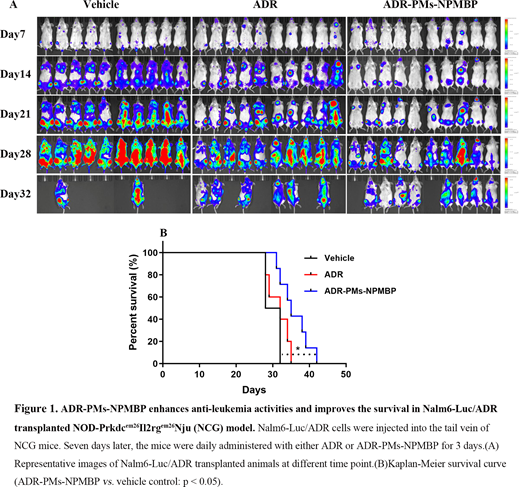Acute lymphoblastic leukemia (ALL) is an aggressive malignancy. Adults with ALL have more than 50% relapse rates and 20-40% overall survival. We previously validated that overexpression of NPM may be involved in the multidrug resistance development and might be important indicator for prognosis evaluation in ALL. In this study, we engineered and synthesized recombinant NPM binding protein (NPMBP). NPMBP and adriamycin (ADR) were bound to polymeric nanoparticle-based drug delivery system and named ADR-PMs-NPMBP (China Patent Application 202010302395.6, 202010739575.0). In this study, we aimed to evaluate thein vitroandin vivoanti-leukemia activity of ADR-PMs-NPMBP in resistant ALL cells. The underlying mechanisms were further addressed.
In vitrostudy data demonstrated that ADR-PMs-NPMBP significantly enhanced chemosensitivity of ALL cells to ADR. The IC50 values of ADR-PMs-NPMBP in 4 ALL cell lines and primary ALL cells from 6 patients were between 1.6‐ and 7.0‐fold lower than those of ADR. Of note, all the resistant ALL cell lines and the primary ALL cells from the relapsed patients, although variable in degree, were sensitive to ADR-PMs-NPMBP. The ratio of apoptosis cells in resistant ALL cells was more than 2‐fold as compared ADR-PMs-NPMBP with single ADR regimen. RNA‐seq analysis showed that there were 5599 and 233 differentially expressed genes in ADR-PMs-NPMBP versus control and ADR-PMs-NPMBP versus ADR comparison groups, respectively. Kyoto Encyclopedia of Genes and Genomes enrichment analysis indicated that 21 pathways play significant roles in ADR-PMs-NPMBP-mediated anti-leukemia activities in ALL. Of note, p53 protein with gene symbol TP53 was interestingly identified to overlap in the 5 pathways as following: Epstein-Barr virus infection, cell cycle, apoptosis, human T-cell leukemia virus 1 infection and p53 signaling pathway. Further validation experiments showed that ADR-PMs-NPMBP-induced effects on cell viability were due to the multiple roles of the activated p53 in apoptosis induction and cell cycle arrest.
In vivostudy showed that ADR-PMs-NPMBP regimen was well tolerated by both resistant ALL xenograft BALB/C-nude model and ALL cell transplanted NOD-Prkdcem26Il2rgem26Nju (NCG) model. No systemic toxicity occurrence was observed after the recipients were intraperitoneally administered with ADR-PMs-NPMBP at 25 mg/kg/day for 3 days. The body weights of the animals increased with the time in both tumor model systems. Of note, whole-body bioluminescence imaging showed that less tumor cell burden was observed in ADR-PMs-NPMBP-treated recipients as compared to the animals administered with ADR. The tumor inhibition rate achieved as high as 79.2% in ADR-PMs-NPMBP group when finished the following-up. Moreover, studies on NCG model showed that ADR-PMs-NPMBP conditioning sensitized the antileukemia response of the resistant ALL xenograft model to ADR. Wright‐Giemsa staining results demonstrated that more mature myeloid cells and lymphocytes were presented in the bone marrow samples from ADR-PMs-NPMBP‐conditioned mice. In contrast, the increased immature blast cells were observed in the bone marrow from vehicle control mice and ADR-treated mice. Notably, the regimen of ADR-PMs-NPMBP diminished or blocked simultaneous metastases to multiple organs including liver and spleen, and significantly prolonged mouse survival.
In conclusion, our study provides the first evidence that ADR-PMs-NPMBP nanoparticle may exert apoptotic inductionviathe activation of p53 pathway and markedly improve the antileukemia effect of ADR in resistant ALL cellsin vitroandin vivo. Our data indicate that the novel drug delivery system may be valuable to develop as a new strategy for the treatment of ALL, particularly for the resistant ALL.
No relevant conflicts of interest to declare.
Author notes
Asterisk with author names denotes non-ASH members.


This feature is available to Subscribers Only
Sign In or Create an Account Close Modal